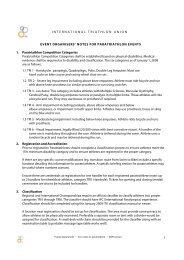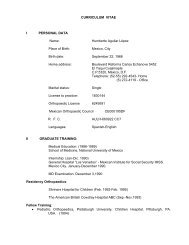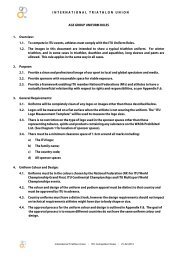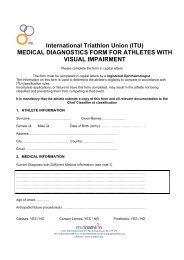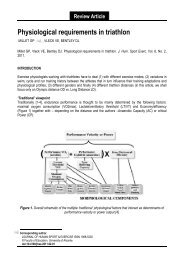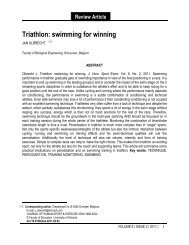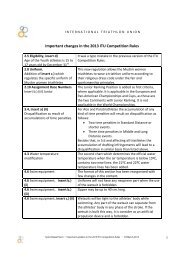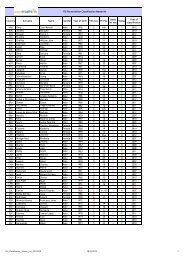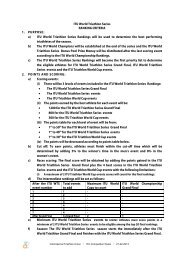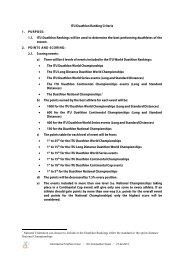ITU Paratriathlon Classification Rules and Regulations 2012 Edition ...
ITU Paratriathlon Classification Rules and Regulations 2012 Edition ...
ITU Paratriathlon Classification Rules and Regulations 2012 Edition ...
Create successful ePaper yourself
Turn your PDF publications into a flip-book with our unique Google optimized e-Paper software.
arms slightly impaired or missing below the elbow. Able to grip h<strong>and</strong>lebar with<br />
or without prosthesis.<br />
PROFILE 23:<br />
PROFILE 24:<br />
PROFILE 25:<br />
PROFILE 26:<br />
PROFILE 27:<br />
PROFILE 28:<br />
PROFILE 29:<br />
PROFILE 30:<br />
PROFILE 31:<br />
PROFILE 32:<br />
PROFILE 36:<br />
PROFILE 37a:<br />
ONE LOWER LIMB REDUCED IN FUNCTION. Moderate to slight paresis,<br />
spasticity, athetosis or total absence of one lower limb. One leg moderately<br />
impaired or absent below the knee, (50% or less of lower leg remaining), can<br />
usually run if fit enough. Amputation through the forefoot is not eligible.<br />
ONE UPPER LIMB REDUCED IN FUNCTION. Moderate to slight paresis,<br />
spasticity, athetosis or total absence of one upper limb below the elbow. One<br />
arm slightly impaired, unable to grip h<strong>and</strong>lebars with one h<strong>and</strong>.<br />
FOUR LIMBS AND TRUNK REDUCED IN STATURE. Height of four foot three<br />
inches or below (129.5 cm) – Not Eligible in <strong>Paratriathlon</strong>.<br />
FOUR LIMBS REDUCED IN FUNCTION. Moderate to slight paresis, spasticity,<br />
athetosis or deformity in all four limbs. Balance <strong>and</strong> gross co-ordination<br />
affected.<br />
26a: moderate to slight spasticity or athetosis in all four limbs.<br />
26b: moderate to slight paresis or deformity in all four limbs.<br />
TWO CONTRALATERAL LIMBS REDUCED IN FUNCTION. Severe to moderate<br />
paresis, spasticity, athetosis, deformity or absence of opposite arm <strong>and</strong> leg.<br />
Opposite arm <strong>and</strong> leg severely impaired or absent<br />
TWO LOWER LIMBS REDUCED IN FUNCTION. Severe to moderate paresis or<br />
degeneration in both hips. Lower spine affected. Both hips impaired causing<br />
difficulty walking, usually a waddling gait. The hip impairment must be<br />
sufficient to cause poor or no pelvic control.<br />
TWO UPPER LIMBS REDUCED IN FUNCTION. Severe to moderate paresis in<br />
both upper limbs. Both shoulders impaired.<br />
TRUNK REDUCED IN FUNCTION. Severe to moderate paresis, or deformity in<br />
trunk or neck.<br />
FOUR LIMBS REDUCED IN FUNCTION. Severe paresis, spasticity, athetosis or<br />
deformity in both lower limbs. Slight paresis, spasticity, athetosis or deformity<br />
in both upper limbs. Trunk also involved. Usually unable to move out of base of<br />
support.<br />
FOUR LIMBS REDUCED IN FUNCTION. Severe paresis, spasticity, athetosis or<br />
deformity in both upper limbs. Slight to moderate paresis, paresis, athetosis, or<br />
deformity in both lower limbs. Trunk also involved.<br />
TOTALLY BLIND. No light perception in either eye, up to light perception but<br />
inability to recognise the shape of a h<strong>and</strong> at any distance or in any direction.<br />
See APPENDIX 4.<br />
PARTIAL SIGHT. From the ability to recognise the shape of a h<strong>and</strong> up to a<br />
visual acuity of 2/60 or visual field of less than 5 degrees. See APPENDIX 4.<br />
24




